Shock or no shock ? – How F. Langenhorst and A. Deutsch manipulated scientific results – which continues to have an effect to this day: See
— the comment article on a 2010 paper by Bevan M. French and Christian Koeberl
— the previous web pages on this ugly story
— the 2001 elimination of the Azuara impact structure from the Canadian Earth Impact Database under the management of John Spray. Until today no re-inclusion in the database and concealment of all proven impact findings (as well as the complete ignoring of the Rubielos de la Cérida impact basin in the database). Note: Azuara and Rubielos de la Cérida may show much more impact evidence than 90 % of all impact structures that are considered proven in the Canadian database. – Do your own check!
— These guidelines from the so-called “impact community” were warmly welcomed by a considerable part of Spanish geologists (especially by the University of Zaragoza and IGME), because they were able to justify the complete rejection of this enormous and for Spanish geology so great event.
— Even today, the latest Spanish geological literature makes no mention of the impact.
— To this day, there is no Spanish geologist (other than the very few directly involved researchers) who has publicly acknowledged or offered to cooperate in one of the most important Spanish geological events with fantastic, easily accessible geological outcrops.
— Poor Spanish students of geoscience who are kept away from modern, highlighting Spanish geology by their teachers in lectures and excursions and in the literature.
In the following the “source”: the Langenhorst & Deutsch scientific dishonesty and manipulation (and a compilation of Azuara strong shock effects):
In an LPSC abstract article, Langenhorst & Deutsch (1996) [The Azuara and Rubielos structures, Spain: Twin impact craters or Alpine thrust systems? TEM investigations on deformed quartz disprove shock origin (abstract). Lunar and Planetary Science, v. XXVII: 725-726.] pretend that there is no evidence for shock in the Azuara impact structure. They base their presumption on a TEM analysis of a sample taken by one of the present authors (K.E.) from far outside the Azuara structure (!). Moreover, Langenhorst & Deutsch completely ignored the detailed description (given by K.E. to them) of the sample showing basal deformation lamellae and not PDFs (planar deformation features) and published the misleading results, although K.E. had informed them about their basic mistake. It is emphasized here that shock effects (diaplectic and melt glass, diaplectic crystals, PDFs, kink bands in mica, planar fractures in quartz) have always been reported (Ernstson et al. 1985, Fiebag 1988, Ernstson & Claudín 1990, Mayer 1991, Ernstson & Fiebag 1992, Ernstson 1994, and others) for polymict breccias within the Azuara structure and for the Pelarda Fm. impact ejecta (see below). These papers, however, are not cited by Langenhorst and Deutsch in their LPSC paper. This was the reason why we reproached Alexander Deutsch and Falko Langenhorst with scientific dishonesty.
Still in 2002, Falko Langenhorst contrary to the truth used the article written by Ernstson et al. (1985) to conceal their LPSC blunder. In an article
Shock metamorphism of some minerals: Basic introduction and microstructural observations. – Bulletin of the Czech Geological Survey, Vol. 77, No. 4, 265–282, 2002
F. Langenhorst is writing:
“Sub-planar features of tectonic origin such as the so-called Böhm lamellae have been erroneously assigned as PDFs (Ernstson et al. 1985, Vrána 1987; Fig. 8a). TEM studies have deciphered the nature of these tectonic features, as being subgrain boundaries.”
Langenhorst’s reference Ernstson et al. 1985 relates to Ernstson, K. , Hammann, W., Fiebag, J. and Graup, G.: Evidence of an impact origin for the Azuara structure (Spain). – Earth and Planetary Science Letters, 74, 361-370, 1985, and in this article the authors Ernstson et al. are writing (cited from the EPSL article):
“5. Shock-deformation features
The sandstone components of the Nogueras polymict breccia described above provide the key to understanding the extraordinary geologic set¬ting around Azuara. In thin section, the quartz grains in the sandstone clasts display deformation features bearing evidence of shock metamorphism. Such deformation features of quartz, termed planar features or planar elements ([22] and references therein) are shown in Fig. 6. The planes of defor¬mation are crystallographically controlled and, according to current knowledge, they can be gen¬erated only by shock ([22], and references therein, [24,26.28]). The distribution of shock features throughout the rock fragments is highly irregular. Areas with nearly each of the quartz grains dis¬playing one or more systems of planar elements (Fig. 6.A) alternate with areas almost devoid of them. A maximum of five intersecting systems per grain have been observed, although one orienta¬tion per grain is the rule. Both decorated and non-decorated planar elements [27] have been found. A frequency diagram of the measured an¬gles between the quartz c-axes and the normals to the planes of planar elements indicates predomi¬nance of sets parallel to (1013) and (1012) (Fig. 7). Basal sets are of minor importance.
Shock-wave recovery experiments on quartz single crystals [23,24] indicate that (1013) planar elements develop above 10 GPa ( = 100 kbar), whereas (1012) elements develop above 16 GPa, becoming as abundant as (1013) sets at about 25 GPa. However, caution is required in making di¬rect analogies between experimental data and nat¬ural events due to the strongly different duration of the shock pressure [25]. Nevertheless, the promi¬nent and prevailing (1013) and (1012) orientations of quartz from the Azuara breccia suggest shock pressures exceeding 10 GPa [26-28]. For compari¬son, Fig. 7 shows results of universal stage mea¬surements from a number of North American impact craters [26.29]. The similar characteristics of all three histograms are clearly visible.”
And here are the relevant figures of the Ernstson et al. EPSL article:


We contrast:
F. Langenhorst:
- — Sub-planar features of tectonic origin such as the so-called Böhm lamellae have been erroneously assigned as PDFs (Ernstson et al. 1985, …..
- — TEM studies have deciphered the nature of these tectonic features, as being subgrain boundaries.
Ernstson et al. 1985:
- — In thin section, the quartz grains in the sandstone clasts display deformation features bearing evidence of shock metamorphism. Such deformation features of quartz, termed planar features or planar elements ([22] and references therein) are shown in Fig. 6.
- — The planes of defor¬mation are crystallographically controlled and, according to current knowledge, they can be gen¬erated only by shock ([22], and references therein, [24,26.28]) …..
- — A maximum of five intersecting systems per grain have been observed, although one orienta¬tion per grain is the rule.
- — Both decorated and non-decorated planar elements [27] have been found.
- — A frequency diagram of the measured an¬gles between the quartz c-axes and the normals to the planes of planar elements indicates predomi¬nance of sets parallel to (1013) and (1012) (Fig. 7).
- — Nevertheless, the promi¬nent and prevailing (1013) and (1012) orientations of quartz from the Azuara breccia suggest shock pressures exceeding 10 GPa [26-28].
- –For compari¬son, Fig. 7 shows results of universal stage mea¬surements from a number of North American impact craters [26.29]. The similar characteristics of all three histograms are clearly visible.
We think we need not further comment on this falsification of scientific results by F. Langenhorst, and his 2002 paper shows that there is not any necessity of revoking our reproach of scientific dishonesty.
We furthermore need not emphasize that these misleading results stated by A. Deutsch and F. Langenhorst were just what the Spanish geologists (e.g., Cortés et al., 2002) from the Zaragoza university and the Madrid Center of Astrobiology were waiting for. They continue to refer to the Deutsch and Langenhorst papers to undergird their opposition against the Azuara impact structure, they continue to adopt the misleading results and, hence, the scientific dishonesty.
More shock metamorphism in Azuara rocks
The following images and captions unambiguously prove the clear and abundant shock metamorphism in rocks from the Azuara structure and its unambiguous impact origin. Ignoring these facts, apart from Falko Langenhorst and Alexander Deutsch also practiced by John Spray and the Canadian Earth Impact Database at the university of New Brunswick, demonstrates that suppression of science and scientists is still a most popular method.
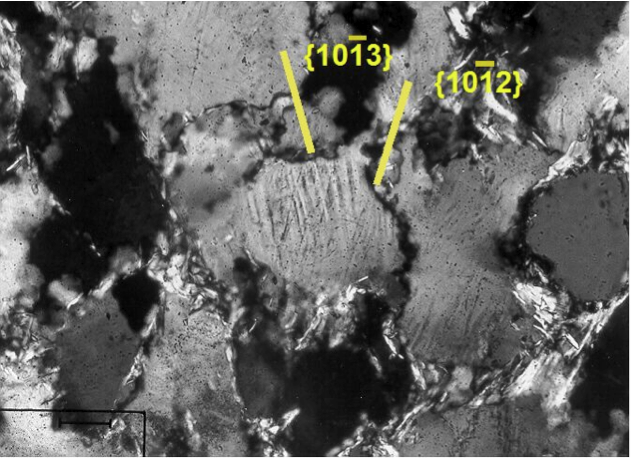 Fig. 1. Planar deformation features (PDFs) in quartz from the Pelarda formation ejecta. Photomicrograph, crossed nicols. The {10-13} and {10-12} crystallographical orientations of the sets suggest shock pressures exceeding 10 GPa (= 100 kbar). The field is 200 µm wide. Photomicrograph E. Guerrero
Fig. 1. Planar deformation features (PDFs) in quartz from the Pelarda formation ejecta. Photomicrograph, crossed nicols. The {10-13} and {10-12} crystallographical orientations of the sets suggest shock pressures exceeding 10 GPa (= 100 kbar). The field is 200 µm wide. Photomicrograph E. Guerrero
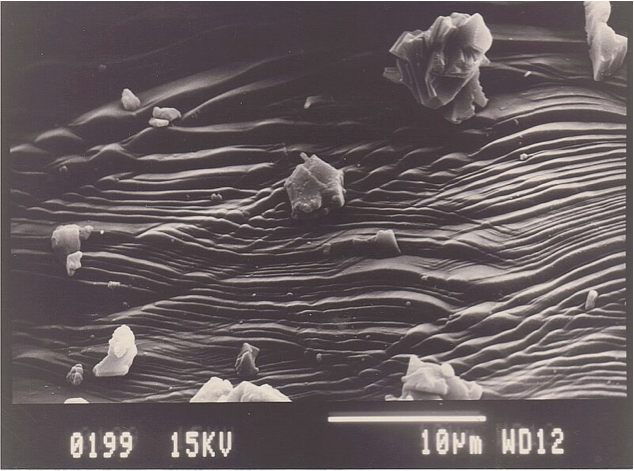 Fig. 2. SEM image of two sets of crossing PDFs in quartz from the Pelarda Fm. ejecta. Note the spacing of the individual PDFs, which is distinctly less than 1 µm in many cases.
Fig. 2. SEM image of two sets of crossing PDFs in quartz from the Pelarda Fm. ejecta. Note the spacing of the individual PDFs, which is distinctly less than 1 µm in many cases.
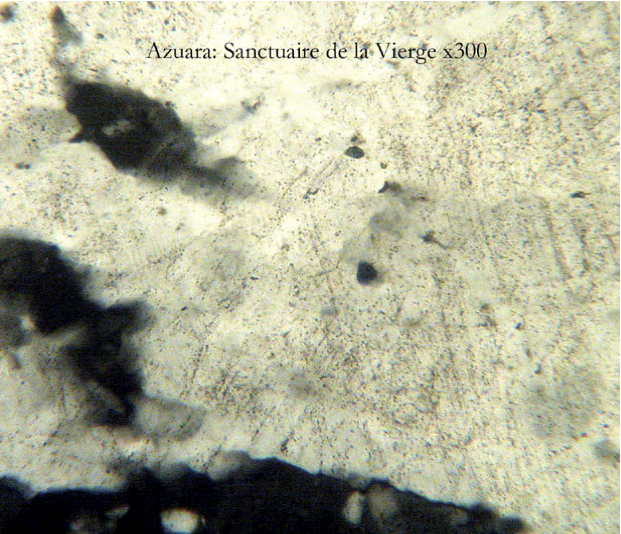 Fig. 3. Multiple sets of PDFs in quartz, Virgen de Herrera. Breccia sample, thin section, and photomicrograph: Alain Weissler (France – Société Astronomique de France, Commission des “Météorites, Impactisme, phénomènes lumineux”).
Fig. 3. Multiple sets of PDFs in quartz, Virgen de Herrera. Breccia sample, thin section, and photomicrograph: Alain Weissler (France – Société Astronomique de France, Commission des “Météorites, Impactisme, phénomènes lumineux”).
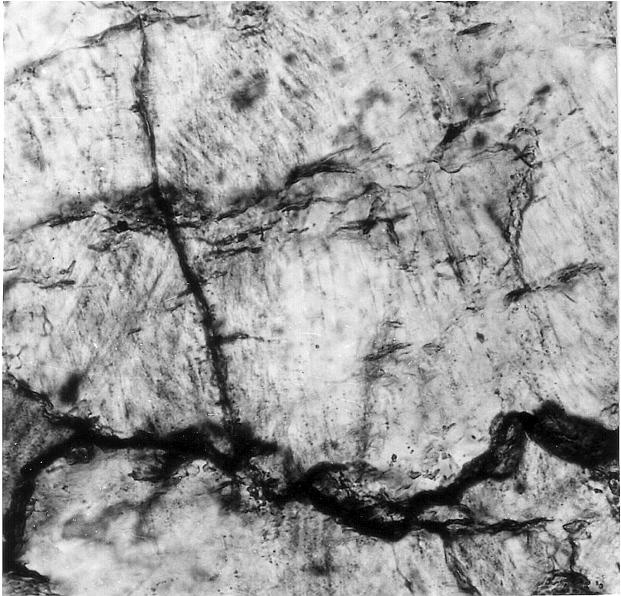 Fig. 4. Multiple sets of PDFs in quartz; polymictic breccia, near Santa Cruz de Nogueras. The field is 140 µm wide.
Fig. 4. Multiple sets of PDFs in quartz; polymictic breccia, near Santa Cruz de Nogueras. The field is 140 µm wide.
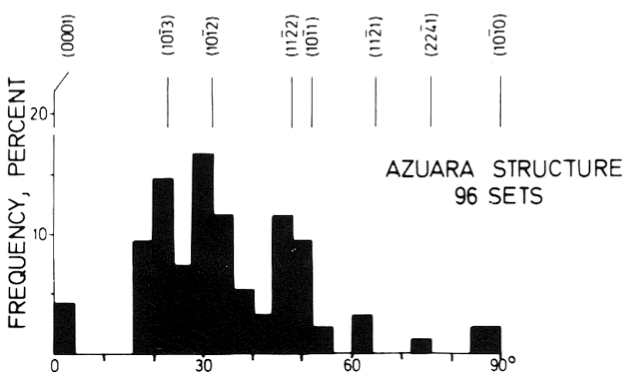 Fig. 5. Frequency diagram of crystallographic orientation of planar deformation features (PDFs) in quartz of sandstone components from Azuara polymictic breccia near Santa Cruz de Nogueras. The prominent and prevailing (10-13) and (10-12) orientations suggest shock pressures exceeding 10 GPa (= 100 kbar). Diagram taken from Ernstson et al. (1985); also see above: Shock or no shock?
Fig. 5. Frequency diagram of crystallographic orientation of planar deformation features (PDFs) in quartz of sandstone components from Azuara polymictic breccia near Santa Cruz de Nogueras. The prominent and prevailing (10-13) and (10-12) orientations suggest shock pressures exceeding 10 GPa (= 100 kbar). Diagram taken from Ernstson et al. (1985); also see above: Shock or no shock?
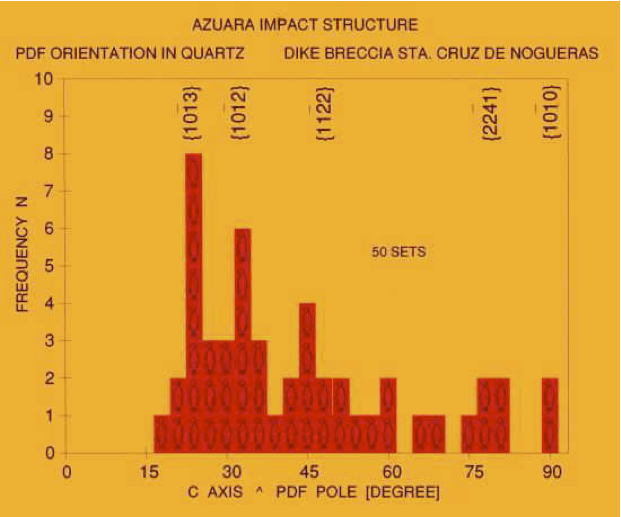 Fig. 6. Frequency diagram of crystallographic orientation of planar deformation features (PDFs) in quartz of sandstone components from Azuara mixed breccia near Santa Cruz de Nogueras. The universal-stage measurements were made by Eugenio Guerrero Serrano at the Department of Petrology, Complutense University, Madrid. The frequency diagram is very similar to the diagram (Fig. 5) published in Earth and Planetary Science Letters by Ernstson et al. (1985).
Fig. 6. Frequency diagram of crystallographic orientation of planar deformation features (PDFs) in quartz of sandstone components from Azuara mixed breccia near Santa Cruz de Nogueras. The universal-stage measurements were made by Eugenio Guerrero Serrano at the Department of Petrology, Complutense University, Madrid. The frequency diagram is very similar to the diagram (Fig. 5) published in Earth and Planetary Science Letters by Ernstson et al. (1985).
A third and independent investigation of PDFs in samples from the Azuara impact structure (a polymict dike breccia and Pelarda Fm. ejecta) was made at the Geological Survey of Canada by Ann Therriault. She analyzed the crystallographical orientation of PDFs in quartz and other parameters such as density, sharpness, spacing, and spreading over the grain (Fig. 7). Up to five sets of PDFs per grain were observed. The spacing is 1 µm or less, the PDF density high. Practically all sets are decorated. All shocked grains have reduced birefringence of 0.004 – 0.008.
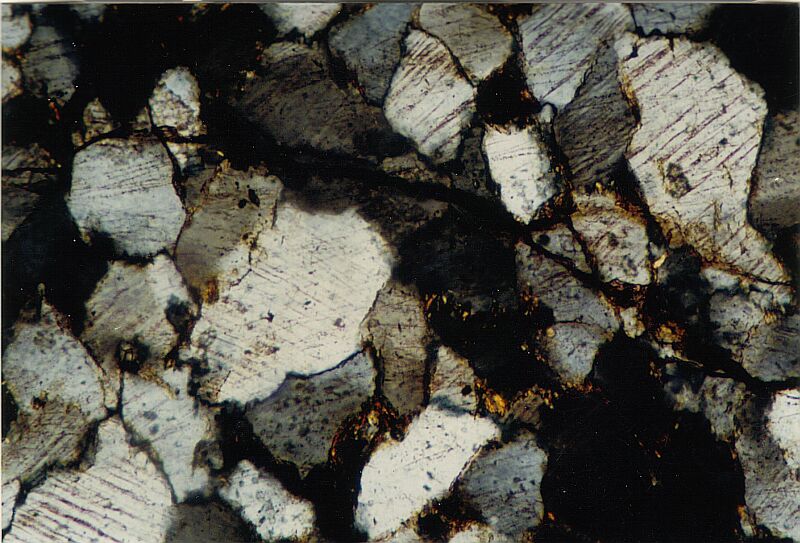 Fig. 7. Planar deformation features in quartz grains; strongly shocked polymictic breccia, Azuara impact structure, Spain. These shocked breccia quartz grains were the basis for the PDF analyses performed by Dr. Ann Therriault (see Figs 8, 9).
Fig. 7. Planar deformation features in quartz grains; strongly shocked polymictic breccia, Azuara impact structure, Spain. These shocked breccia quartz grains were the basis for the PDF analyses performed by Dr. Ann Therriault (see Figs 8, 9).
A frequency diagram for the PDF crystallographical orientation is presented below in Fig. 8. A comparison of the three analyses of the Azuara PDFs (by Kord Ernstson (Fig. 5), Eugenio Guerrero (Fig. 6), and Ann Therriault (Fig. 8) shows large similarities.
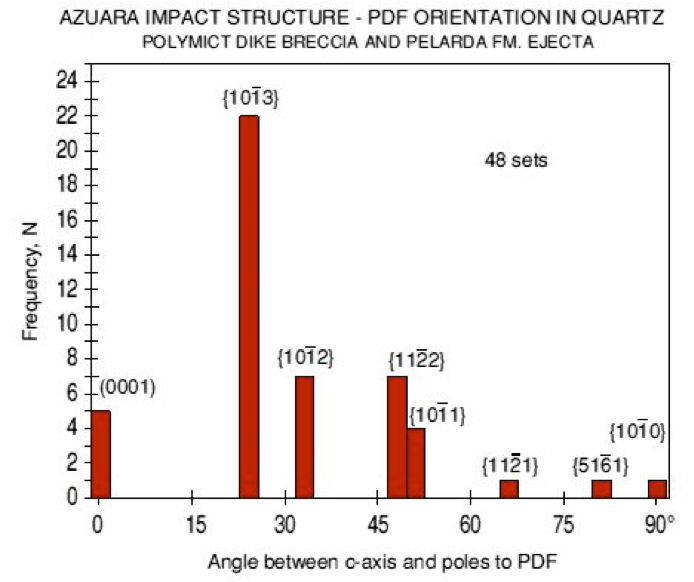 Fig. 8. Frequency diagram of crystallographic orientation of planar deformation features (PDFs) in quartz from a polymict dike breccia and from the Pelarda Fm. ejecta. The diagram is based on data elaborated by A. Therriault.
Fig. 8. Frequency diagram of crystallographic orientation of planar deformation features (PDFs) in quartz from a polymict dike breccia and from the Pelarda Fm. ejecta. The diagram is based on data elaborated by A. Therriault.
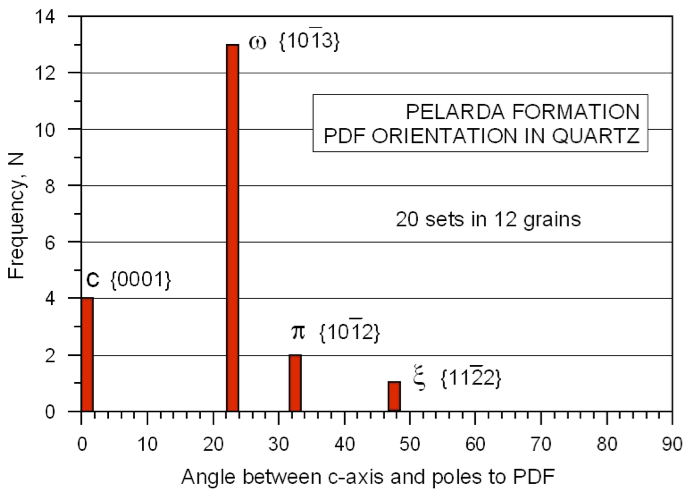 Fig. 9. Frequency diagram of crystallographic orientation of planar deformation features (PDFs) in quartz from the Pelarda Fm. ejecta. Data are part of the data set in Fig. 8.
Fig. 9. Frequency diagram of crystallographic orientation of planar deformation features (PDFs) in quartz from the Pelarda Fm. ejecta. Data are part of the data set in Fig. 8.
The prevailing {10-13} and {10-12} PDF orientations in the shocked samples from the Azuara structure are unusual considering the sedimentary (porous) target in which {11-22} and {10-11} directions commonly are more typical. The “crystalline” signature of the Azuara PDFs, however, may be explained by the lithology of the target. The impact affected a sedimentary column (several kilometers thick) composed of Paleozoic consolidated rocks (quartzites, phyllites, schists, and others), Mesozoic consolidated rocks (predominantly limestones), and Lower Tertiary unconsolidated rocks. The latter may be considered a molasse deposit of probably more than 1000 m thickness. It was composed of rocks originating from the erosion of the emerging Iberian Chain and, consequently, composed of dense Mesozoic and Paleozoic components. We suggest that the practically non-porous Paleozoic quartzites, phyllites, schists, and few granitoids, enabled the development of PDFs otherwise rather typical of crystalline targets (Stöffler et al. 1994, Grieve et al. 1996). Since these Paleozoic materials were preferentially sampled from the Pelarda Fm. ejecta and from breccia dikes and used for PDF universal-stage analyses (Figs. 7, 8), the prevailing orientations mentioned above may be understood. Therefore, we suggest that despite the high porosity of the deposit, the “crystalline” PDF signature could develop, because, in the end, the material’s lithology is more important. This is a partially different view with regard to the paper of Grieve et al. (1996), although we basically share the authors’ opinion that lacking porosity and grain-size distribution are the leading factors.
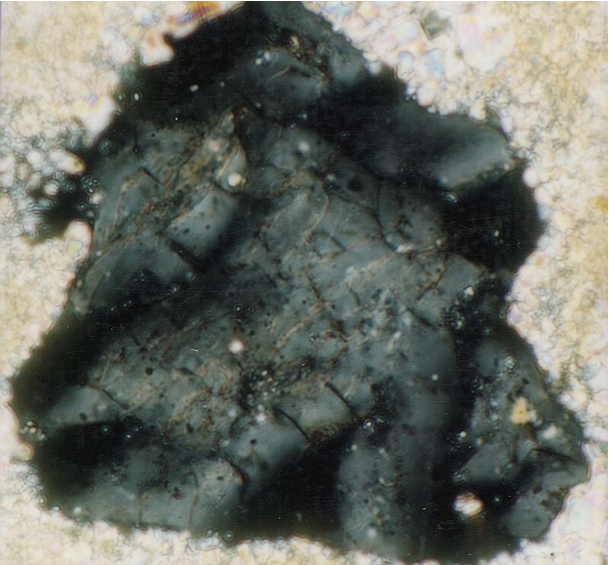 Fig. 10. Partly isotropic quartz grain (diaplectic crystal) from a dike breccia. This shock deformation requires pressures exceeding 10 GPa (= 100 kb). Also note multiple sets of planar fractures as the probable result of shock. Photomicrograph, crossed nicols; the field is 195 µm wide. Photo courtesy of G. Mayer.
Fig. 10. Partly isotropic quartz grain (diaplectic crystal) from a dike breccia. This shock deformation requires pressures exceeding 10 GPa (= 100 kb). Also note multiple sets of planar fractures as the probable result of shock. Photomicrograph, crossed nicols; the field is 195 µm wide. Photo courtesy of G. Mayer.
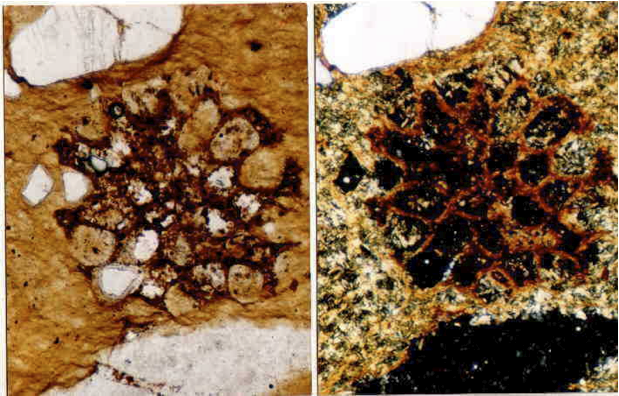 Fig. 11. Diaplectic glass in a strongly shocked polymict breccia from the Azuara impact structure near Santa Cruz de Nogueras; photomicrograph. The sandstone fragment is composed of diaplectic quartz grains embedded within partly recrystallized silicate melt. Plane polarized light (left) and crossed nicols (right). Note that there are a few holes in the thin section not to be confused with diaplectic quartz grains. The field is 600 µm wide.
Fig. 11. Diaplectic glass in a strongly shocked polymict breccia from the Azuara impact structure near Santa Cruz de Nogueras; photomicrograph. The sandstone fragment is composed of diaplectic quartz grains embedded within partly recrystallized silicate melt. Plane polarized light (left) and crossed nicols (right). Note that there are a few holes in the thin section not to be confused with diaplectic quartz grains. The field is 600 µm wide.
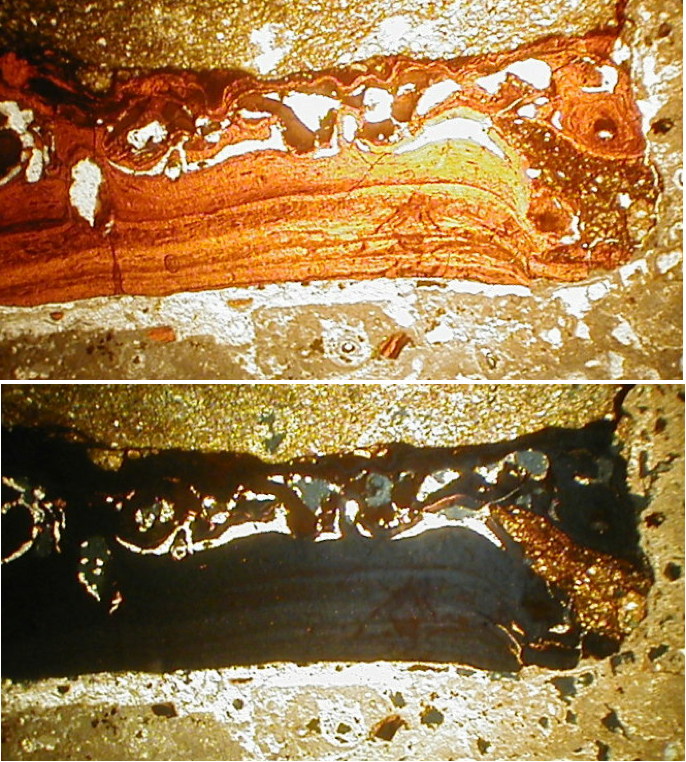 Fig. 12. Melt Melt glass with vesicles, schlieren and mineral fragments; photomicrograph, plane light and crossed polarizers. Strongly shocked breccia, near Santa Cruz de Nogueras, Azuara impact structure, Spain. The field is 9 mm wide.
Fig. 12. Melt Melt glass with vesicles, schlieren and mineral fragments; photomicrograph, plane light and crossed polarizers. Strongly shocked breccia, near Santa Cruz de Nogueras, Azuara impact structure, Spain. The field is 9 mm wide.
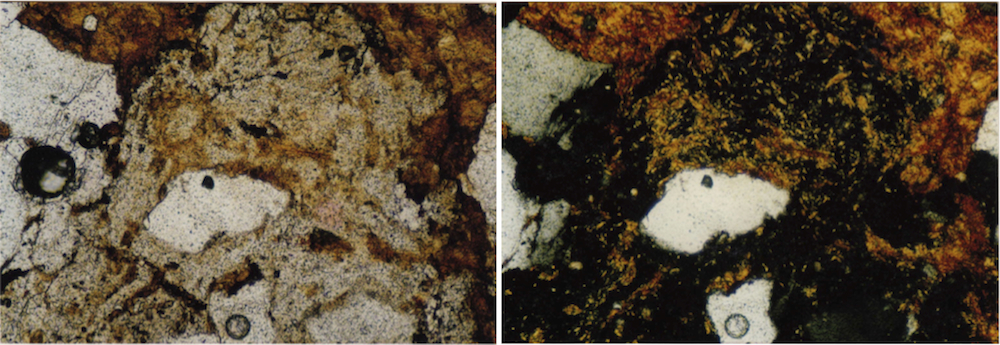 Fig. 13. Partly recrystallized melt glass; photomicrograph, plane light (left) and crossed polarizers. Strongly shocked dike breccia, near Santa Cruz de Nogueras, Azuara impact structure, Spain. The field is 1 mm wide.
Fig. 13. Partly recrystallized melt glass; photomicrograph, plane light (left) and crossed polarizers. Strongly shocked dike breccia, near Santa Cruz de Nogueras, Azuara impact structure, Spain. The field is 1 mm wide.
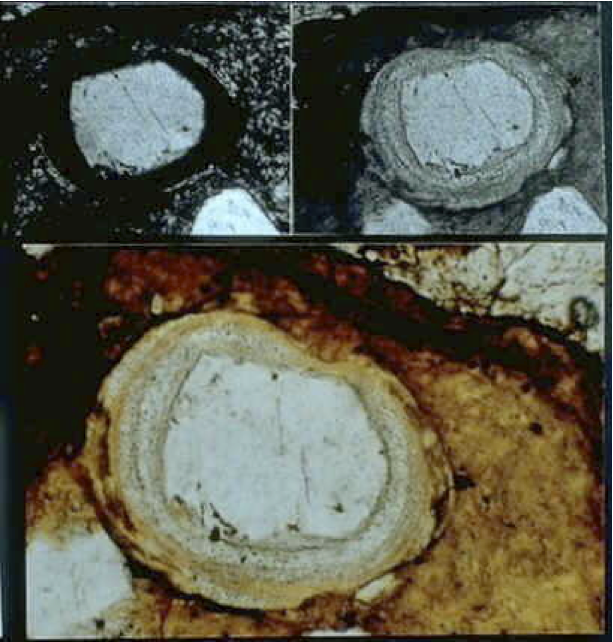 Fig. 14. Quartz grain coated with melt-glass. Photomicrographs; crossed nicols (top left) and plane polarized light. From a strongly shocked polymict breccia; near Nogueras, Azuara impact structure. The field is 200 µm wide.
Fig. 14. Quartz grain coated with melt-glass. Photomicrographs; crossed nicols (top left) and plane polarized light. From a strongly shocked polymict breccia; near Nogueras, Azuara impact structure. The field is 200 µm wide.
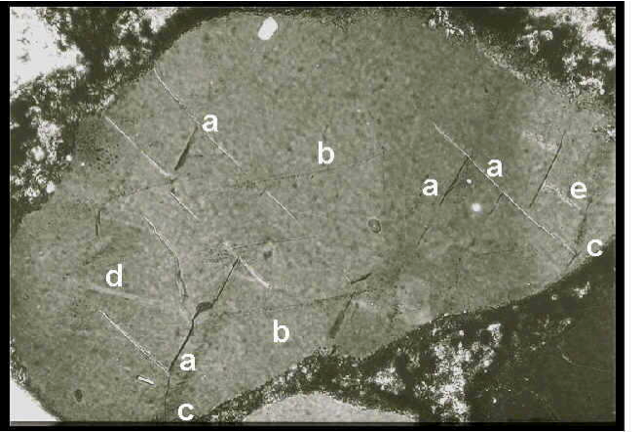 Fig. 15. Photomicrograph (crossed nicols) of cleavage in quartz typical of shock wave damage, but very uncommon in tectonically deformed quartz. Six sets of different orientation can be observed. Crystallographic planes (10-11) [a], (0001) [b], and (51-61) [c] are determined by universal-stage measurements. Azuara impact structure; sandstone fragment of a polymict breccia near Nogueras. The field is 450 µm wide.
Fig. 15. Photomicrograph (crossed nicols) of cleavage in quartz typical of shock wave damage, but very uncommon in tectonically deformed quartz. Six sets of different orientation can be observed. Crystallographic planes (10-11) [a], (0001) [b], and (51-61) [c] are determined by universal-stage measurements. Azuara impact structure; sandstone fragment of a polymict breccia near Nogueras. The field is 450 µm wide.
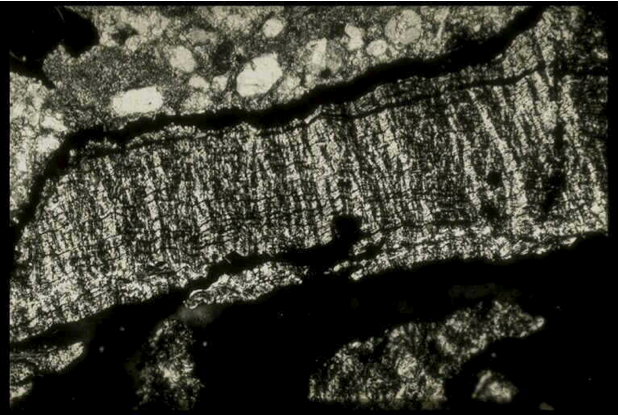 Fig. 16. Kink bands in biotite from a highly shocked polymict breccia (Azuara impact structure, near Nogueras). Photomicrograph, crossed nicols; the field is 840 µm wide. Although kink bands can be formed under static conditions of strong regional metamorphism, the high frequency of the kink bands shown here, their narrow width, and their high kink-angle asymmetry point to shock deformation.
Fig. 16. Kink bands in biotite from a highly shocked polymict breccia (Azuara impact structure, near Nogueras). Photomicrograph, crossed nicols; the field is 840 µm wide. Although kink bands can be formed under static conditions of strong regional metamorphism, the high frequency of the kink bands shown here, their narrow width, and their high kink-angle asymmetry point to shock deformation.






































































